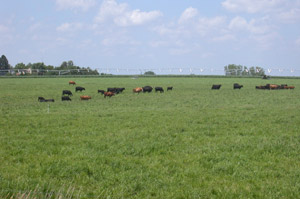December 2014
 With a strong demand for pasture and low grain prices, there has been a renewed interest in the use of irrigated pasture. There are a number of different annual and perennial forage species that could be used.
With a strong demand for pasture and low grain prices, there has been a renewed interest in the use of irrigated pasture. There are a number of different annual and perennial forage species that could be used.
Annuals do allow for flexibility in terms of crop rotations and the length of time between seeding and grazing can be relatively short. However, the expense of planting a cool- and warm-season annual in a double-crop strategy can be significant.
Once established, irrigated perennial grasses will have consistent production for multiple years. Cool- or warm-season perennial grasses could be used, but cool-season grasses generally have the advantage because of their longer growing period, quicker establishment time, persistence under grazing, and response to irrigation and fertilizer.
Other important planning and management considerations for irrigated pasture include determining how the pasture will be used and fit into your overall operation and the site selection and previous cropping history of the field. Additionally, plans are needed for livestock fence and water development as well as irrigation, fertilizer, and grazing management plans.
A series of webinars has been developed to help answer many of these questions.
- Perennial Forages for Irrigated Pasture: provides an overview of the different species, seeding rates, and mixtures that are available
- Establishing Irrigated Pasture: discusses seeding dates and options and establishment year management
- Fertilizer and Water Management for Irrigated Pasture: provides guidelines on fertilizer rates and irrigation scheduling
- Grazing Management of Irrigated Pasture: discusses stocking rates, pasture rotations, and grazing strategies
Several extension publications pertaining to irrigated pasture are available.
- Perennial Forages for Irrigated Pasture (PDF version, 688KB)
- Certified Perennial Grass Varieties Recommended for Nebraska (PDF 485KB)
- Fertilizing Grass Pastures and Hayland (PDF version, 711KB)
- Forage Production with Limited Irrigation (PDF version, 860KB)
Jerry Volesky
Professor
Range and Forage Systems Specialist
University of Nebraska